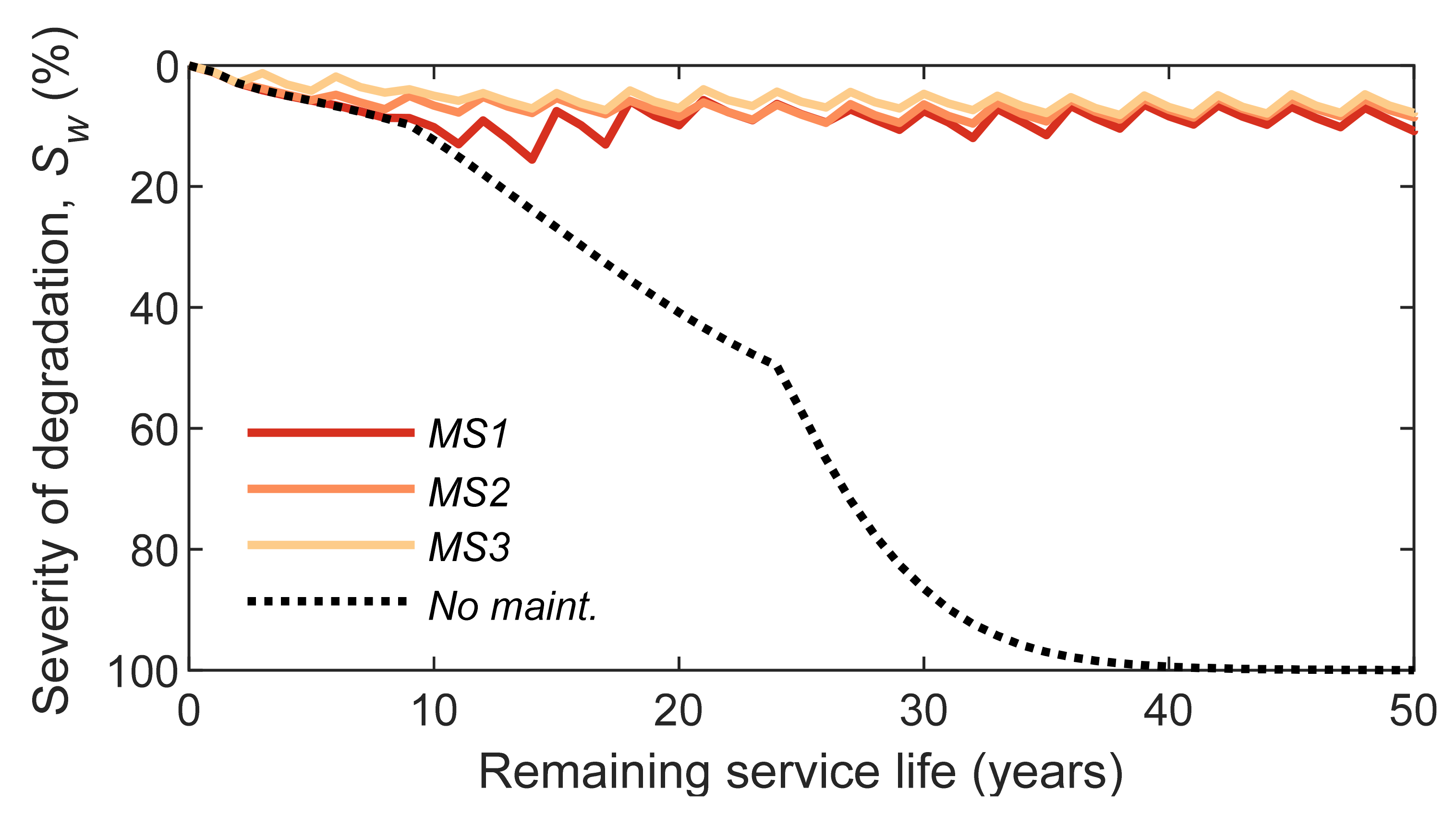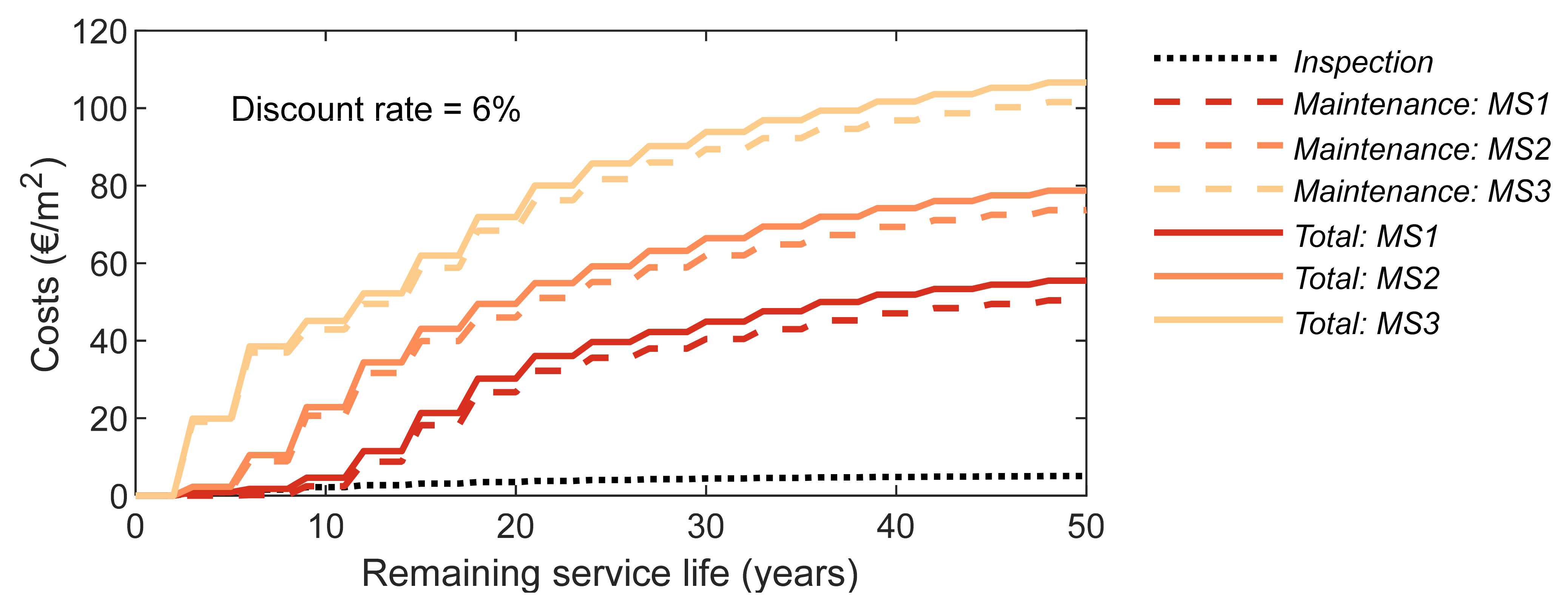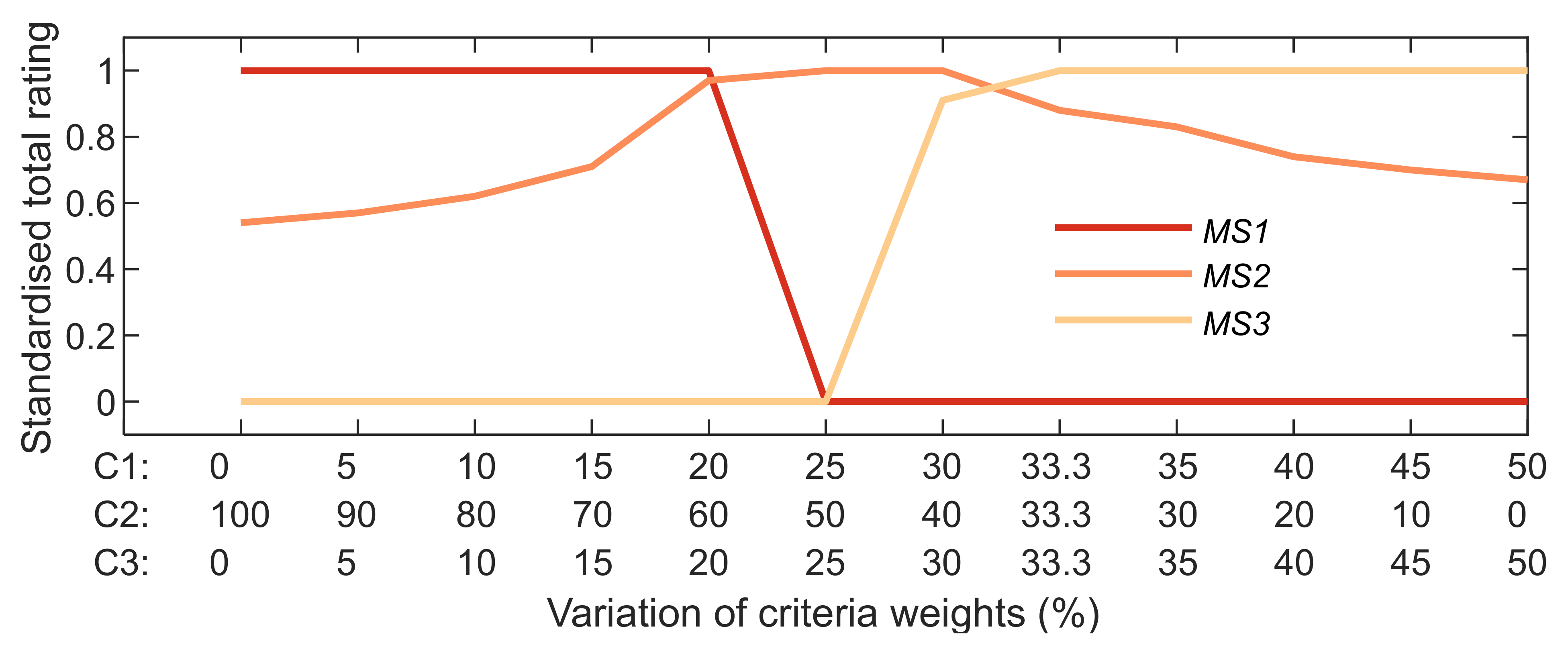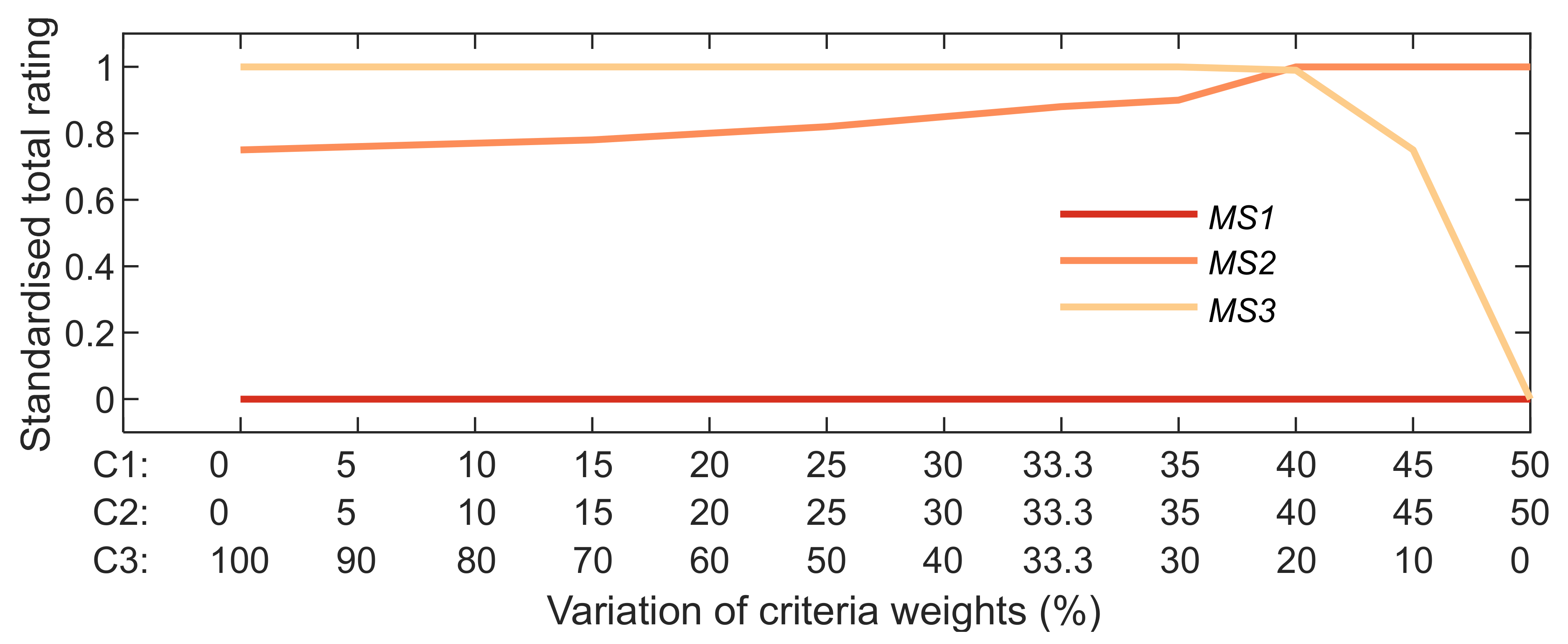In this case study, three maintenance strategies are analysed to investigate their influence on ETICS. The maintenance strategies selected range from total replacement of the cladding (MS1), a moderate intervention (MS2) that includes minor interventions and total replacement, and a more careful intervention (MS3) that combines cleaning operations, minor interventions, and total replacement. The aim of MS1 is to represent the maintenance strategy most commonly used by owners/managers [
38], while MS2 and MS3 represent maintenance strategies more complete.
Table 2 and
Table 3 present the input data of the maintenance model. In
Table 2, the optimal parameters of the degradation process are identified. In this study, it is considered that the degradation process follows a Weibull distribution [
55]. The parameters in
Table 2 are presented in terms of mean,
Ti, and standard deviation,
SDi, of the sojourn time in each degradation condition. For instance, for ETICS, the transition between conditions A and B takes, on average, 1.8 years to occur, with a standard deviation of 2.4 years. The same analysis can be used for other condition transitions. In
Table 3, the data related with the maintenance activities are presented, namely costs, application zones and the impacts in the cladding (in terms of probabilities,
P). The information presented in this table can be understood in the following way: for ETICS, a cleaning operation has a cost of 26.88 €/m
2 (including scaffolding installation), can only be applied when the cladding is in condition B, and has a probability of 34.9% of improving the cladding’s condition to A and 65.1% of maintaining condition B. Furthermore, a time horizon,
th, of 50 years, a time interval between inspection of 3 years, and an initial severity of degradation,
Sw, of 0% (condition A) at the beginning of the analysis are assumed.
In
Table 3, all costs are estimated based on CYPE cost database [
56] and the impact of the maintenance activities is based on the historical in situ inspection data, by assessing the impact that the different interventions have on the severity of degradation index,
Sw [
57]. The following assumptions are adopted to estimate the costs and the impact of the maintenance activities:
3.1. Individual Analysis of the Parameters
For this case study, the end of the service life for the three maintenance strategies (MS1 to MS3) and for the situation without maintenance is presented in
Figure 1 as black dots. This figure reveals that the performance of regular preventive maintenance activities (such as cleaning operations minor interventions) over the time horizon has a significant impact on the service life of the ETICS. For example, by comparing with MS1 or no maintenance, MS2 allows delaying the ETICS’s total replacement by 15 years (increasing the service life from 17 to 32 years) and MS3 by 27 years (increasing the service life from 17 to 44 years).
Furthermore, two other observations should be made based on
Figure 1. First, the cumulative distribution functions of the three maintenance strategies are related with the first total replacement performed on the ETICS, i.e., according to the time horizon defined, it is possible that the ETICS go through more than one total replacement. However, to estimate the service life of the maintenance strategy, only the cumulative distribution function of the first replacement is relevant. Secondly, the service lives obtained for MS1 and for the situation without maintenance are equal. As mentioned before, in MS1 only total replacement is considered; therefore, these two situations will have the same behaviour until condition D is reached. In other words, for the two situations, the ETICS degrades continuously until condition D without any maintenance being performed. When condition D is achieved, for MS1 the cladding is completely replaced while, in the situation without maintenance, the cladding continues to degrade. This can be checked through the average degradation curves (
Figure 2).
In
Figure 2, the average degradation curves, in terms of severity of degradation, are compared for the three maintenance strategies and for the situation without maintenance. In contrast to the degradation curve of MS1, the degradation curve of the situation without maintenance degrades continuously until condition E (
Sw > 50%—
Table 1). Once this condition is reached, the cladding remains in condition E until some action is taken (replacement or demolition). In MS1, since the maintenance plan specifies that the cladding is replaced whenever condition D (30% <
Sw ≤ 50%) is reached (
Table 3), the average severity of degradation,
Sw, improves significantly over the time horizon, ranging between 0 and 20%. In
Figure 2, each “peak” in the degradation curves corresponds to an inspection moment where the ETICS is intervened in an independent degradation curve. Since Monte Carlo simulation is implemented in the maintenance model to deal with uncertainty, in the degradation curve not only one “peak” that would correspond to the exact moment in which the intervention would be performed is visible, but rather several “peaks” that propagate over time, because the moments in which the interventions are carried out are distinct in the different independent degradation curves. In addition, by comparing the three maintenance strategies, it is found that, as the maintenance strategies become more complex (from MS1 to MS3), the average severity of degradation,
Sw, becomes better (more favourable) over time. This observation can be corroborated by the efficiency index,
EI, (
Table 4).
As explained in
Section 2.2, the efficiency index measures the ability of one maintenance strategy to maintain the cladding in a good condition, and is given by the percentage of area underneath the degradation curve (
Figure 2)—Equation (4).
Table 4 shows that, as the maintenance strategies become more complex, the efficiency index increases (from 0.37 to 0.93 for the time horizon of 50 years), meaning that the maintenance strategies are more efficient and, consequently, the claddings remain longer in the most favourable degradation conditions, such as conditions A and B, over the time horizon.
Finally, if the costs of the three maintenance strategies studied are compared (
Figure 3), the results reveal, as expected, that, as the maintenance strategies become more complex, their expected cost over the time horizon increases. In this study, MS3 is the solution that has the highest maintenance costs (101.54 €/m
2, at year 50) and MS1 the solution with the lowest maintenance costs (50.40 €/m
2, at year 50). For the three maintenance strategies, the inspection costs are equal (5.06 €/m
2, at year 50) since an inspection period of 3 years is adopted in all analyses. Furthermore, the results show that the maintenance costs are very significant when compared with the initial costs of application of the ETICS. A cost of 78.38 €/m
2 is assumed as an initial cost of application of the ETICS. The total cost of MS1 corresponds, approximately, to 71% of the initial cost; MS2 corresponds to 100%; and MS3 corresponds to 136% (corresponds to the cost of a new ETICS plus the cost of demolition of the old cladding and transport, deposition and treatment of constructive waste generated by the intervention).
Furthermore, the maintenance strategy costs are directly related with the number of interventions.
Figure 4 compares the average number of interventions by maintenance strategy. As the maintenance strategies become more complex, the global number of interventions increases, which implies the increase of their associated costs. On the other hand,
Figure 4 reveals that the number of total replacements decreases as the complexity of the maintenance strategies increases, confirming that more complex maintenance strategies are best options when it is important to reduce the users’ annoyance and discomfort during the time horizon.
3.2. Multi-Criteria Decision Analysis
In this study, a multi-criteria decision analysis is used to globally rank the different maintenance strategies. For that purpose, three parameters are analysed: C1—Efficiency index; C2—Maintenance costs (including the inspection costs); and C3—Total number of replacements.
Figure 5,
Figure 6 and
Figure 7 present the results obtained by the MCDA (in
Appendix A are presented the initial decision-making matrix—
Table A1; the normalized decision-making matrix—
Table A2; and the ranking results for the three case—
Table A3,
Table A4 and
Table A5). These figures show how the global ranking of the different maintenance strategies varies according to the criteria adopted. The variation of the efficiency index weights is presented in
Figure 5, the maintenance costs in
Figure 6, and the total number of replacements in
Figure 7.
When the MCDA is implemented, MS1 is considered the most favourable alternative only in situations where high importance is given to the maintenance costs in detriment of the other two criteria (
Figure 6). For weights below 60%, MS1 is no longer the most favourable alternative. In addition, when the weight of the other two criteria changes, MS1 always represents the least beneficial option (
Figure 5 and
Figure 7). On the other hand, in general, MS3 is the most favourable alternative for a greater number of combinations between the weights of the criteria. For example, for the variation of the efficiency index (
Figure 5), MS3 only ceases to be the most favourable alternative for weights below 30%; for the number total of replacements (
Figure 7), for weights below 20%; and, for the maintenance costs (
Figure 6), for weights above 33.3%. Finally, MS2 is an intermediate solution, being the best alternative when the weights of the efficiency index (
Figure 5) or the number total of replacements (
Figure 7) are low, or when the weight of the maintenance cost (
Figure 6) varies between 33.3% and 60%.
3.3. Discussion
As a direct consequence of the new directives on building energy efficiency [
13,
15,
58], ETICS application has increased in the last years thanks to its thermal performance. In comparison with conventional solutions, ETICS are considered a recent cladding material [
59] and, consequently, studies are needed to understand the ETICS performance over time. These studies are crucial for the development of maintenance models to manage the maintenance interventions, in order to increase the ETICS’ durability and ensure their functionality during their service life.
The results from this study reveal that maintenance plays an important role to increase the durability of ETICS, and therefore their sustainability. They also show that the performance of regular maintenance activities allows increasing the service life and improving the degradation condition of the ETICS over time (the claddings remain longer in more favourable conditions, with less defects and less interventions), thus corroborating, the observations of several previous studies [
5,
6,
8,
9,
10].
From the individual analysis of the parameters (
Section 3.1), by comparing with the situation without maintenance, all maintenance strategies studied improve the performance of ETICS, in terms of the severity of degradation over time and, consequently, in terms of the efficiency index, but lead to higher maintenance costs, i.e., more complex maintenance plans (MS3) are related with:
Better efficiency indexes (
Table 4). MS3 is more efficient (higher efficiency index) than MS1 and MS2. ETICS under MS3 spends 9% more time in the best degradation conditions (A and B) than MS2, and more 21% than MS1;
Higher service lives (
Figure 1). ETICS under MS3 presents a higher service life by comparing with the other two maintenance strategies (15 years more than MS2 and 27 years more than MS1);
Higher maintenance costs (
Figure 3). From the three maintenance strategies, MS3 is the most expensive maintenance strategy while MS1 is the most economical. The cost, by square meter, of MS1 is, approximately, 50% that of the cost of MS3; and,
Lower number of total replacements (
Figure 4). As the complexity of the maintenance plans increases, the number of deep interventions (replacements) is considerably reduced. The number of total replacements of MS3 is, approximately, 25% that of MS1.
However, the definition of the more beneficial maintenance strategy from the individual analysis of the parameters is a challenging task. Since the parameters are interdependent, when one parameter is optimised, the others deviate from the optimal value (since the parameters are dependent, as one parameter improves in the MCDA, the others naturally tend to present worse results). Furthermore, this type of decision process is rather subjective [
59], since the weight of the different criteria can change according to the personal perceptions and requirements of the decision-makers, local constraints, social and economic contexts, among other criteria.
For example, if maintenance cost is the only parameter considered to choose a maintenance strategy (a common situation in the maintenance sector), MS1 becomes the best alternative since it is the solution with the lowest maintenance costs (
Figure 3), while MS3 corresponds to the worst option. Because of this choice, the durability and performance of the ETICS will be considerably reduced. For the same time horizon, the service life can be reduced by 27 years, the time in the best degradation conditions can be reduced by 21% and, consequently, the distress in the normal use of the building can increase four times.
On the other hand, when all parameters are analysed jointly (
Section 3.2), different outcomes can result. Its only advantage is the reduced maintenance costs. These results demonstrate that, if some emphasis is given on the ETICS’s durability, aesthetical appearance or users comfort, the implementation of regular monitoring and maintenance activities in the maintenance strategy are clearly the best approach. In addition, a lower number of total replacements also has an impact on the sustainability of this cladding system. Consequently, from the analysis of
Figure 5,
Figure 6 and
Figure 7, for different combinations of weights in the criterion, MS3 is globally ranked as the most advantageous maintenance strategy.
Although this methodology can be generalized to different constructive solutions, these observations are only validated for this constructive solution. If an analysis of a different constructive solution of ETICS is performed, the costs of the interventions for the new constructive solution must be estimated, since the costs will influence the results of the analysis. On the other hand, if the aim is to perform an analysis for a different type of cladding, for example natural stone, ceramics or rendering, in addition to costs, new parameters for the degradation process and new impacts of the maintenance activities must be assessed.
















